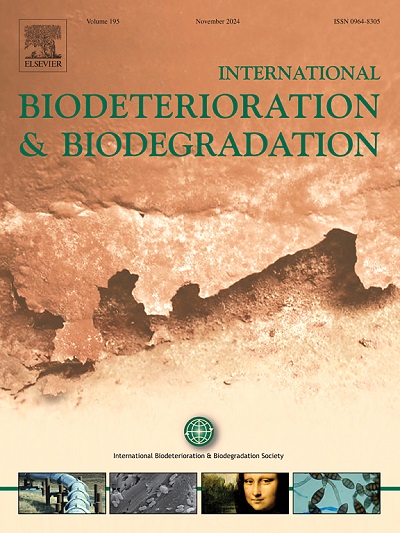新分离的微细菌sp. F2完全矿化双酚F,消除其对敏感生物的毒性
IF 4.1
2区 环境科学与生态学
Q2 BIOTECHNOLOGY & APPLIED MICROBIOLOGY
International Biodeterioration & Biodegradation
Pub Date : 2025-05-03
DOI:10.1016/j.ibiod.2025.106109
引用次数: 0
摘要
双酚F (BPF)是合成环氧树脂和聚碳酸酯塑料的一种组分。在水中和沉积物中经常检测到其残留,由于双酚pf的内分泌干扰作用,对水生生物构成威胁。本研究分离到了以BPF为唯一碳源生长的菌株Microbacterium sp. F2,该菌株在24 h内降解了98.67%的0.10 mM BPF。基于代谢物鉴定,菌株F2通过桥接碳原子羟基化降解BPF,随后通过氧化和bayer - villiger反应生成对羟基苯甲酸(PHBA)和1,4-对苯二酚(HQ),并进一步代谢,为菌株F2提供生长所需的碳源。BPF、4,4′-二羟基苯甲酮(DHBP)、4-羟基苯基- 4-羟基苯甲酸酯(HPHB)、HQ和PHBA对椭球小球藻96 h的半最大抑制浓度(IC50)分别为64、142.5、205、325和660 μM。BPF及其代谢物对球蛾的毒性呈逐渐降低的趋势。BPF、DHBP、HPHB、HQ和PHBA对斑马鱼96 h的中位致死浓度(LC50)分别为40.50、70.31、71.28、72.44和74.94 μM。代谢物对斑马鱼的毒性无明显差异,但其毒性显著低于BPF。然而,菌株F2对BPF的完全矿化实现了BPF的解毒。本研究为bpf污染环境的生物修复提供了一种潜在菌株。本文章由计算机程序翻译,如有差异,请以英文原文为准。

Complete mineralization of bisphenol F by a newly isolated Microbacterium sp. F2 eliminates its toxicity to sensitive organisms
Bisphenol F (BPF) is a component of synthetic epoxy resin and polycarbonate plastic. Its residue is frequently detected in water and sediments, posing a threat to aquatic organisms due to the endocrine disrupting effect of BPF. In this study, strain Microbacterium sp. F2, using BPF as the sole carbon source for growth and degrading 98.67 % of 0.10 mM BPF within 24 h, was isolated. Based on the identification of metabolites, strain F2 degraded BPF by the hydroxylation of the bridging carbon atom, and subsequently via oxidation and Baeyer-Villiger reaction to p-hydroxybenzoic acid (PHBA) and 1,4-hydroquinone (HQ), and both of them were further metabolized to provide strain F2 with the carbon source for growth. The half maximal inhibitory concentration (IC50) of BPF, 4,4′-dihydroxybenzophenone (DHBP), 4-hydroxyphenyl 4-hydroxybenzoate (HPHB), HQ and PHBA against Chlorella ellipsoidea at 96 h were 64, 142.5, 205, 325 and 660 μM, respectively. The toxicity of BPF and its metabolites to C. ellipsoidea showed a gradually decreasing trend. The median lethal concentration (LC50) of BPF, DHBP, HPHB, HQ, and PHBA against zebrafish at 96 h were 40.50, 70.31, 71.28, 72.44, and 74.94 μM, respectively. There was no obvious difference in the toxicity of metabolites to zebrafish, but their toxicity was significantly lower than that of BPF. However, the complete mineralization of BPF by strain F2 achieved the detoxification of BPF. This study provides a potential strain for the bioremediation of BPF-polluted environment.
求助全文
通过发布文献求助,成功后即可免费获取论文全文。
去求助
来源期刊
CiteScore
9.60
自引率
10.40%
发文量
107
审稿时长
21 days
期刊介绍:
International Biodeterioration and Biodegradation publishes original research papers and reviews on the biological causes of deterioration or degradation.

 求助内容:
求助内容: 应助结果提醒方式:
应助结果提醒方式:


